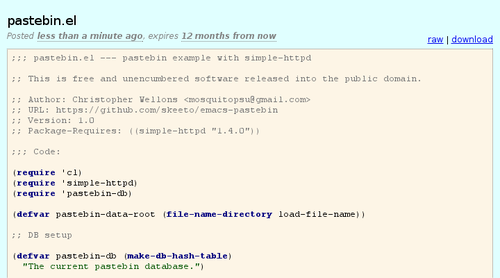nullprogram.com/blog/2012/12/29/
(The author is currently open to employment opportunities in the United
States.)
Luke is doing an interesting threefive-part tutorial on writing
a pastebin in PHP: PHP Like a Pro (2, 3,
4, 5). The tutorial is largely an introduction to
the set of tools a professional would use to accomplish a more
involved project, the most interesting of which, for me, is
Vagrant.
Because I have no intention of ever using PHP, I decided to
follow along in parallel with my own version. I used Emacs Lisp with
my simple-httpd package for the server. I really
like my servlet API so was a lot more fun than I expected it to be!
Here’s the source code,
Here’s what it looked like once I was all done,

It has syntax highlighting, paste expiration, and light version
control. The server side is as simple as possible, consisting of only
three servlets,
/pastebin/: static files/pastebin/get: serves (immutable) pastes in JSON/pastebin/post: accepts new pastes in JSON, returns the ID
A paste’s JSON is the raw paste content plus some metadata, including
post date, expiration date, language (highlighting), parent paste ID,
and title. That’s it! The server is just a database and static file
host. It performs no dynamic page generation. Instead, the client-side
JavaScript does all the work.
For you non-Emacs users, the repository has a pastebin-standalone.el
which can be used to launch a standalone instance of the pastebin
server, so long as you have Emacs on your computer. It will fetch any
needed dependencies automatically. See the header comment of this file
for instructions.
IDs
A paste ID is four or more randomly-generated numbers, letters, dashes
or underscores, with some minor restrictions (pastebin-id-valid-p).
It’s appended to the end of the servlet URL.
/pastebin/<id>/pastebin/get/<id>
In the first case, the servlet entirely ignores the ID. Its job is
only to serve static files. In the second case the server looks up the
ID in the database and returns the paste JSON.
The client-side inspects the page’s URL to determine the ID currently
being viewed, if any. It performs an asynchronous request to
/pastebin/get/<id> to fetch the paste and insert the result, if
found, into the current page.
Form submission isn’t done the normal way. Instead, the submission is
intercepted by an event handler, which wraps the form data up in JSON
(much cleaner to parse!) and sends it asynchronously to
/pastebin/post via POST. This servlet inserts the paste in the
database and responds in text/plain with the paste ID it
generated. The client-side then redirects the browser to the paste URL
for that paste.
Features
As I said, the server performs no page generation, so syntax
highlighting is done in the client with
highlight.js. I could have used htmlize
and supported any language that Emacs supports. However, I wanted to
keep the server as simple as possible, and, more importantly, I
really don’t trust Emacs’ various modes to be secure in operating on
arbitrary data. That’s a huge attack surface and these modes were
written without security in mind (fairly reasonable). It’s actually a
deliberate feature for Emacs to automatically eval Elisp in comments
under certain circumstances.
Version control is accomplished by keeping track of which paste was
the parent of the paste being posted. When viewing a paste, the
content is also placed in a textarea for editing. Submitting this form
will create a new paste with the current paste as the parent. When
viewing a paste that has a parent, a “diff” option is provided to view
a diff patch of the current paste with its parent (see the screenshot
above). Again, the server is dead simple, so this patch is computed by
JavaScript after fetching the parent paste from the server.
Databases
As part of my fun I made a generic database API for the servlets, then
implemented three different database backends. I used eieio, Emacs
Lisp’s CLOS-like object system, to implement this API. Creating a new
database backend is just a matter of making a new class that
implements two specific methods.
The first, and default, implementation uses an Elisp hash table for
storage, which is lost when Emacs exits.
The second is a flat-file database. I estimate it should be able to
support at least 16 million different pastes gracefully. The on-disk
format for pastes is an s-expression. Basically, this is read by
Emacs, expiration date checked, converted to JSON, then served to the
client.
To my great surprise there is practically no support for programmatic
access to a SQL database from GNU Emacs Lisp (other Emacsen do). The
closest I found was pg.el, which is asynchronous by
necessity. However, the specific target I had in mind was SQLite.
I did manage to implement a third backend that uses SQLite, but it’s
a big hack. It invokes the sqlite3 command line program once for
every request, asking for a response in CSV — the only output format
that seems to escape unambiguously. This response then has to be
parsed, so long as it’s not too long to blow the regex stack.
Update February 2014: I have
found a solution to this problem!
Future
This has been an educational project for me. As a tutorial and for
practice I’ll probably write the server again from scratch using other
languages and platforms (Node.js and Hunchentoot maybe?), keeping the
same front-end.